
CAUTION: CERTAIN LARGE, CIRCULAR OR IRREGULARLY SHAPED OBJECTS
MAY REQUIRE ADDITIONAL HOLDING MEANS IF THEY CANNOT BE HELD
SECURELY IN VISE.
CAUTION: DO NOT CUT MAGNESIUM WITH THIS TOOL. Damage to the saw and
personal injury may result.
MAXIMUM CUTTING CAPACITY
NOTE: Capacity shown on chart assumes no wheel wear and optimum fence position.
Standard Equipment
1 14" (355 mm) metal cutting abrasive wheel
1 Allen wrench
1 Instruction manual
To Carry (Fig. 1)
Fold down unit to position where you can carry the saw. Push in lock pin (A) to lock arm
down.
Unlocking (Fig. 1)
To unlock tool and raise head, depress motor arm slightly and pull lock pin (A) out. Motor
arm will then pivot upward.
Material Clamping and Supporting
• Angles are best clamped and cut with both legs resting against base.
• A spacer block slightly narrower than the workpiece can be used to increase wheel
utilization (Fig. 3).
• Long workpieces must be supported by a block so it will be level with top of base
(Fig. 4). The cut-off end should be free to fall downward to avoid wheel binding.
Spark Defl ector Adjustment (Fig. 1)
To best deflect sparks away from surrounding persons and materials, loosen the screw
(B), adjust the spark deflector (C) and then retighten screw.
CAUTION: Risk of property damage. Do not allow cordset to come into contact with
deflector or sparks as damage to cordset may occur.
Vise Operation (Fig. 5)
The vise has a quick travel feature. To release the vise (F) when it is clamped tightly, turn
the crank (H) counterclockwise one or two times to remove clamping pressure. Lift the vise
lever (I) up. Pull crank assembly out as far as desired. The vise may be shoved into work
without cranking. Lower vise lever then tighten vise on work by using crank.
Fence Operation (Fig. 5)
WARNING: To reduce the risk of injury, turn unit off and disconnect machine
from power source before installing and removing accessories, before adjusting
or changing set-ups or when making repairs. Be sure the trigger switch is in the OFF
position. An accidental start-up can cause injury.
The fence (E) requires no tools to adjust. The quick-release clamp lever (T) unlocks and
locks the fence. When the lever is rotated fully forward, the fence is unlocked. The fence
can then be freely moved forward, backward or rotated to allow for the best cutting position
for a new wheel and as the wheel wears.
Rotating the lever fully to the rear locks the fence in position selected. If the bottom leg
of the lever is not horizontal (parallel to the base), the fence is not locked. Lever will only
lock fence when there is strong resistance to moving it to rear. If resistance is light, adjust
clamping force by tightening slightly the two bolts (R) holding the fence to the base. Test
by reclamping and attempt to move fence.
Fence Angle Adjustment (Fig. 6)
WARNING: To reduce the risk of injury, turn unit off and disconnect machine
from power source before installing and removing accessories, before adjusting
or changing set-ups or when making repairs. Be sure the trigger switch is in the OFF
position. An accidental start-up can cause injury.
The angle adjustment indicator is part of fence clamping system. Align the desired angle
indicator line with the edge of the slot in base.
FOR A MORE ACCURATE SQUARE CUT
1. Unlock the fence.
2. Push the arm down until the wheel extends into the base.
3. Place a square against the wheel and adjust the fence against the square.
4. Lock the fence into position.
Usage (Fig. 1, 2)
Refer to Figure 2 for proper body positioning during use.
To start the tool, depress the trigger switch (M). To turn the tool off, release the trigger
switch. Keep hands and material from wheel until it has coasted to a stop.
To prevent unauthorized use of tool, install a standard padlock (not included) into the
padlock hole (N) located in the trigger.
Removal and Installation of Wheels (Fig. 7)
WARNING: To reduce the risk of injury, turn unit off and disconnect machine
from power source before installing and removing accessories, before adjusting
or changing set-ups or when making repairs. Be sure the trigger switch is in the OFF
position. An accidental start-up can cause injury.
The Quick-Change blade clamp requires no tools to change the blade.
1. Push in wheel lock lever (L) and rotate wheel (J) by hand until wheel lock lever
engages slot in inside flange (S) to lock wheel. Loosen the Quick-Change blade clamp
(Q) counterclockwise. Clamp has right-hand thread.
2. Remove the Quick-Change blade clamp (Q), blade clamp washer (U) and old wheel
(J) by hand.
FIG. 1
L
K
I
J
G
F
E
D
C
B
A
N
M
H
FIG. 5
T
H
FORWARD
MARCHE AVANT
REENVIAR
E
I
F
R
10-1/8”
(257 MM)
17-3/8”
(441 MM)
FIG. 8
BLOCK
BLOC
EXTREMO
CORTANTE
CUT OFF
END
EXTRÉMITÉ
COUPÉE
DEL
BLOQUE
FIG. 4
ANGLE ADJUSTMENT INDICATOR
INDICATEUR DE RÉGLAGE DE L’ANGLE
INDICADOR DE AJUSTE DE ÁNGULO
SLOT EDGE
BORD DE
LA FENTE
BORDE DE
LA RANURA
WHEEL / MEULE
DISCO
SQUARE / ÉQUERRE
REGLA
FIG. 6
FIG. 3
WIDTH OF SPACER BLOCK
LARGEUR DE LA CALE
D’ECARTEMENT
PROFUNDIDAD DEL BLOQUE
ESPACIADOR
DIAMETER OF WORK PIECE
DIAMETRE DE LA PIECE
DE TRAVAIL
DIÁMETRO DE LA
PIEZA DE TRABAJO
F
SPACER BLOCK
CALE
D’ECARTEMENT
BLOQUE
ESPACIADOR
E
Y
.3"
(8MM)
FIG. 10
Y
X
V
W
NA IL
CLOU
CLAVO
FIG. 9
20"
(508MM)
2" (50.8MM)
4"
(101.6MM)
FIG. 2
FIG. 7
Q
U
J
S
O
U
P
J
S
3. Make sure flange surfaces are clean and flat. Install the new abrasive wheel by
reversing the above steps.
4. Tighten the Quick-Change blade clamp clockwise until the knob clicks as least
three times to ensure the knob is tight. The Quick-Change blade clamp cannot be
overtightened.
NOTE: A keyed blade clamp system which includes a blade bolt and blade bolt washer,
(Fig. 7 O, P) is available at extra cost from your local dealer or authorized service center.
Please call 1-800-4-D
EWALT (1-800-433-9258) for more information. When using the
keyed blade clamp system, do not overtighten bolt.
WARNING: Risk of personal injury. Check the work surface that the chop saw rests
on when replacing with a new abrasive wheel. It is possible that the wheel may contact
ANY ITEMS OR STRUCTURE THAT EXTENDS ABOVE work surface (under the base)
when the arm is fully lowered.

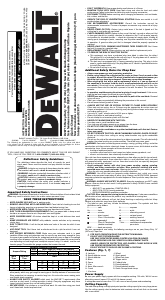


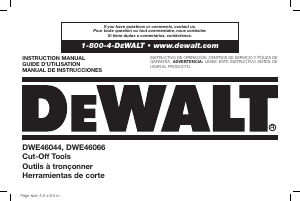
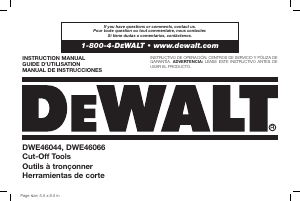
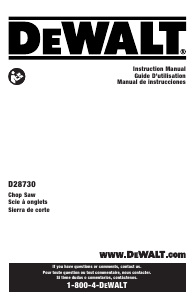
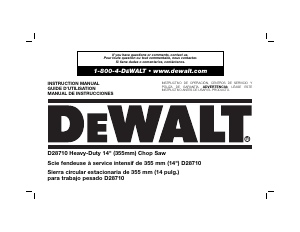
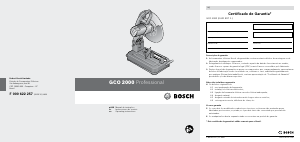
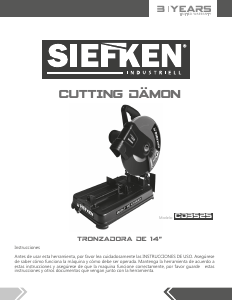
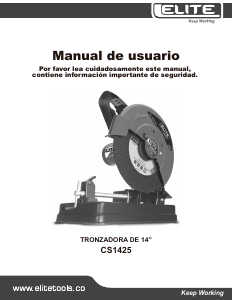
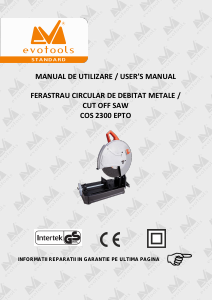
Join the conversation about this product
Here you can share what you think about the DeWalt D28715 Cut Off Saw. If you have a question, first carefully read the manual. Requesting a manual can be done by using our contact form.